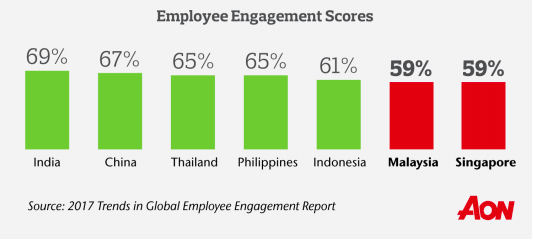The evidence is clear and almost indisputable: Singaporean employees are one of the least engaged in the region.

Source: Aon Hewitt’s 2017 Trends in Global Employee Engagement Study
A report released last year by Aon Hewitt found that Singapore, alongside Malaysia, had the lowest employee engagement in comparison with other major Asian markets. Gallup’s latest State of the Global Workplace report found that up to 75% of workers in Singapore indicated that they were “not engaged” at work. Strangely, in the same report, 71% of Singaporeans agreed that their current job was ideal for them.
“I’m not engaged at work, but this job is ideal for me.”
This seems like a statement worth exploring. Findings from both above-mentioned reports cite reasons such as unhappiness at work, poor leadership and dissatisfaction with work, amongst other reasons, for the low engagement scores.
Here are 3 REAL reasons why we think Singaporeans are the least engaged.
1. Performance (mis) management in our workplaces
With regard to performance conversations, it's common to hear things such as “you have gaps in A, B and C, but of course you’re also strong in D. It’ll be great if you can focus on your weaknesses and improve on them.”
Research linked to motivation and talent is suggesting that employees who use their natural strengths and focus on them are likely to excel and be more effective. When strengths are used, tasks feel less like work and are more enjoyable; leading to a positive psychological reinforcement, and therefore more effective outcomes. And so the virtuous cycle goes.
On the contrary, focusing on weaknesses or gaps isn't intrinsically motivating, and neither does it sustain high performance. Not surprisingly, being the hard workers we are, we always want to know about, and tell others about their weaknesses so that they can improve. After all, isn’t this what a good leader is about? However, employees who are constantly being told about their gaps, or areas of improvement, or weaknesses, are likely not to be enjoying or engaging with their work in the long run. As Helle Bungaard, author of Motivation Factor, puts it: Focusing on weaknesses will help you prevent failures, but it’ll not help you reach excellence.
What does this mean for leaders here?
Organisations that orient performance management conversations and processes around psychological engagement, such as focusing on strengths, are likely to get the most out of their employees. As a leader, consider the next conversation you have with your staff - is it going to focus on their weaknesses or strengths? How are you going to grant employees autonomy and freedom for them to leverage their strengths for effective outcomes?
2. Not having the right opportunities to learn and grow
“Oh I tried to recommend you for this promotion, but HR said no.” Does this sound too familiar?
Amongst the many employee engagement projects that we’ve participated in, a constant finding has been that “my managers don’t provide me with helpful feedback.” From what we’ve gathered across workshops, it seems much easier for people managers to assign feedback duties to HR, other colleagues, or other managers.
As Gallup and Aon Hewitt findings go, increasing employee dissatisfaction is definitely linked to not receiving necessary feedback from immediate managers and not getting the right opportunities to learn and grow. This echoes years of wisdom about people leaving managers, and not companies. People managers who don’t provide timely feedback, or encourage two-way feedback, miss out on opportunities to truly engage their staff.
3. Work-life balance or work-life harmony?
Perhaps one of the reasons for disengagement lies in the way we perceive work and life.
The fact that we spend 8 hours at work and less than that on other things, already suggests that balance is not achievable nor realistic. Subscribing to an outdated mindset might be what’s contributing to dissatisfaction with work life! Instead of seeking a balance, why not adopt a perspective of work-life harmony?
Harmony is achieved when there’s a sense of peace and acceptance towards the fact that work is integrated into life, and it can no longer remain in separate components in the office and at home. For example, I could be leaving the office at 6pm to head to the gym or for dinner, and then find myself having to respond to a couple of emails later on at night - but being perfectly fine with it because of this work-life harmony perspective.
In contrast, someone else might be disturbed with the fact that work emails are disrupting their relaxation after-office hours, and choose to see an imbalance in the work-life scale, therefore stressing themselves out with restoring the balance.
Conclusion
Having an ideal job doesn’t guarantee satisfied employees, in the same way that being a first-world city-state doesn’t guarantee happy citizens. Jobs here may be ideal perhaps in terms of the compensation for the amount of work put in, but there are still unhappy and disengaged employees around.
The solutions to disengagement may actually be much cheaper and within reach than we have imagined. Find out more about the latest research on employee motivation.

